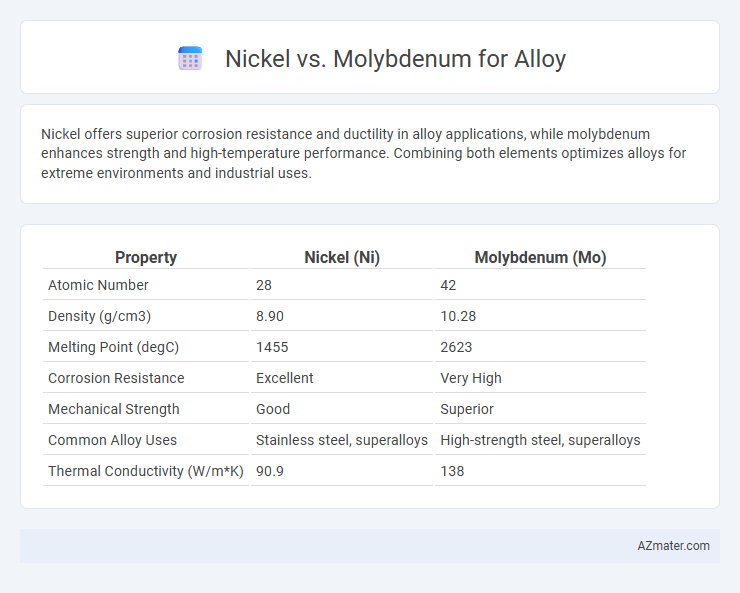Nickel offers superior corrosion resistance and ductility in alloy applications, while molybdenum enhances strength and high-temperature performance. Combining both elements optimizes alloys for extreme environments and industrial uses.
Table of Comparison
| Property | Nickel (Ni) | Molybdenum (Mo) |
|---|---|---|
| Atomic Number | 28 | 42 |
| Density (g/cm3) | 8.90 | 10.28 |
| Melting Point (degC) | 1455 | 2623 |
| Corrosion Resistance | Excellent | Very High |
| Mechanical Strength | Good | Superior |
| Common Alloy Uses | Stainless steel, superalloys | High-strength steel, superalloys |
| Thermal Conductivity (W/m*K) | 90.9 | 138 |
Introduction to Alloying Elements: Nickel and Molybdenum
Nickel and molybdenum are essential alloying elements that significantly enhance the mechanical properties and corrosion resistance of metals. Nickel improves toughness, ductility, and resistance to oxidation, making it ideal for stainless steel and superalloys used in extreme environments. Molybdenum contributes to high strength, creep resistance, and pitting corrosion resistance, especially in stainless steels and high-temperature alloys.
Chemical Properties: Nickel vs Molybdenum
Nickel exhibits excellent corrosion resistance and high ductility due to its atomic structure and electron configuration, making it ideal for alloys that require toughness and resistance to oxidation. Molybdenum offers superior strength at high temperatures and exceptional hardness, attributed to its high melting point and stable carbide formation, enhancing wear resistance in steel alloys. The chemical compatibility of nickel with acids contrasts with molybdenum's prowess in resisting pitting and crevice corrosion, particularly in chloride environments, defining their specialized alloy applications.
Impact on Alloy Strength and Hardness
Nickel significantly enhances alloy strength and hardness by promoting austenitic structures and improving toughness, making it crucial in stainless steels and high-strength alloys. Molybdenum increases hardness through solid solution strengthening and precipitation hardening, offering superior corrosion resistance and high-temperature stability. Alloys with both elements benefit from balanced strength, hardness, and durability, ideal for demanding industrial applications.
Corrosion Resistance Comparison
Nickel alloys exhibit exceptional corrosion resistance in acidic and alkaline environments, making them ideal for chemical processing applications. Molybdenum enhances corrosion resistance primarily against chlorides and localized pitting, especially in stainless steel alloys. Combining both elements in alloys results in superior protection against a broad spectrum of corrosive agents, including oxidizing and reducing conditions.
Role in High-Temperature Performance
Nickel enhances high-temperature performance in alloys by providing excellent oxidation resistance and maintaining structural strength at elevated temperatures, making it essential in superalloys used in turbine engines. Molybdenum contributes to high-temperature strength through solid-solution strengthening and carbide formation, improving creep resistance and thermal stability in steel alloys. Combining nickel and molybdenum results in alloys with superior corrosion resistance and mechanical properties suitable for extreme thermal environments.
Effects on Weldability and Fabrication
Nickel enhances alloy weldability by improving toughness and corrosion resistance, reducing cracking susceptibility during fabrication processes. Molybdenum contributes to increased high-temperature strength and hardness but can decrease ductility, making welding more challenging due to potential hot cracking. Balancing nickel and molybdenum content optimizes weld integrity and fabrication performance in demanding alloy applications.
Cost and Economic Considerations
Nickel and molybdenum are both critical alloying elements with differing cost implications; nickel typically incurs higher raw material expenses due to its greater demand and market volatility, while molybdenum costs fluctuate based on supply chain factors but often remain more stable. Economics favor nickel for applications requiring corrosion resistance and toughness despite its premium price, whereas molybdenum provides cost-effective strength and high-temperature performance in stainless steels and superalloys. Evaluating total lifecycle costs, including processing and durability, is essential for selecting between nickel and molybdenum in alloy design.
Common Industrial Applications
Nickel alloys are widely used in chemical processing, aerospace, and marine industries due to their excellent corrosion resistance and high-temperature strength. Molybdenum is favored in steel alloys for enhanced hardness, wear resistance, and ability to withstand extreme pressures, making it essential in tool manufacturing and heavy machinery. Both elements improve alloy performance, with nickel excelling in corrosion-heavy environments and molybdenum optimizing structural integrity under stress.
Environmental and Safety Implications
Nickel and molybdenum alloys differ significantly in their environmental and safety profiles, with nickel compounds often posing higher allergenic and carcinogenic risks, necessitating stringent occupational exposure controls. Molybdenum, benefiting from lower toxicity and environmental impact, offers safer handling characteristics and reduced regulatory constraints in alloy manufacturing. Selecting molybdenum-enriched alloys can mitigate long-term ecological and human health concerns while maintaining corrosion resistance and mechanical strength.
Choosing Between Nickel and Molybdenum for Alloys
Choosing between nickel and molybdenum for alloys depends on the specific application requirements such as corrosion resistance, strength, and temperature tolerance. Nickel alloys excel in corrosion resistance and toughness, making them ideal for chemical processing and aerospace components, while molybdenum alloys offer superior high-temperature stability and enhanced strength, suitable for power generation and heavy-duty mechanical parts. Cost considerations and environmental exposure also influence the selection, with nickel providing more versatility in diverse conditions and molybdenum delivering exceptional performance in extreme environments.

Infographic: Nickel vs Molybdenum for Alloy
 azmater.com
azmater.com